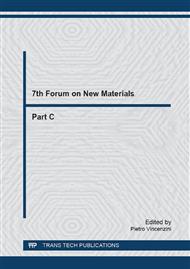[1]
S. Marco, A. Gutiérrez-Gálvez, Signal and data processing for machine olfaction and chemical sensing: a review. IEEE Sensors Journal, (2012) 12(11), 3189-3214.
DOI: 10.1109/jsen.2012.2192920
Google Scholar
[2]
J. Fonollosa, E. Neftci, R. Huerta, S. Marco, Evaluation of calibration transfer strategies between Metal Oxide gas sensor arrays, Procedia Engineering 120 ( 2015 ) 261 - 264.
DOI: 10.1016/j.proeng.2015.08.601
Google Scholar
[3]
P. Walden, J. Kneer, S. Knobelspies, W. Kronast, U. Mescheder, S. Palzer, Micromachined hotplate platform for the investigation of inkjet printed: functionalized metal oxide nanoparticles, J. Microelectromech. Syst., 24 (2015), pp.1384-139.
DOI: 10.1109/jmems.2015.2399696
Google Scholar
[4]
J. Kneer, A. Eberhardt, P. Walden, A. Ortiz-Perez, J. Wöllenstein, S. Palzer, Apparatus to characterize gas sensor response under real-world conditions in the lab, Rev. Sci. Instrum., 85 (2014), p.055006.
DOI: 10.1063/1.4878717
Google Scholar
[5]
B. K. Meyer, A. Polity, D. Reppin, M. Becker, P. Hering, P. J. Klar, T. Sander, C. Reindl, J. Benz, M. Eickhoff, C. Heiliger, M. Heinemann, J. Bl¨asing, A. Krost, S. Shokovets, C. M¨uller, and C. Ronning, Binary copper oxide semiconductors: From materials towards devices Phys. Status Solidi B 249, 1487 (2012).
DOI: 10.1002/pssb.201248128
Google Scholar
[6]
M. Heinemann, B. Eifert, and C. Heiliger Band structure and phase stability of the copper oxides Cu2O, CuO, and Cu4O3, PHYSICAL REVIEW B 87, 115111 (2013).
Google Scholar
[7]
K. Henzler, A. Heilemann, J. Kneer, P. Guttmann, H. Jia, E. Bartsch, Y. Lu, S. Palzer, Investigation of reactions between trace gases and functional CuO nanospheres and octahedrons using NEXAFS-TXM imaging, Sci. Rep., 5 (2015), p.17729.
DOI: 10.1038/srep17729
Google Scholar
[8]
N. Barsan, C. Simion, T. Heine, S. Pokhrel, U. Weimar, Modeling of sensing and transduction for p-type semiconducting metal oxide based gas sensors J Electroceram (2010) 25: 11-19.
DOI: 10.1007/s10832-009-9583-x
Google Scholar
[9]
J. Tamaki, T. Maekawa, N. Miura, N. Yamazoe, CuO-SnO2 element for highly sensitive and selective detection of H2S, Sens. Actuators B: Chem., 8 (1992), pp.197-203.
DOI: 10.1016/0925-4005(92)80216-k
Google Scholar
[10]
J. Kneer, J. Wöllenstein and S. Palzer, Specific, trace gas induced phase transition in copper(II)oxide for highly selective gas sensing, Appl. Phys. Lett. 105, 073509 (2014).
DOI: 10.1063/1.4893736
Google Scholar
[11]
J. Kneer, S. Knobelspies, B. Bierer, J. Wöllenstein, S. Palzer, New method to selectively determine hydrogen sulfide concentrations using CuO layers, Sens. Actuators B: Chem, 222 (2016).
DOI: 10.1016/j.snb.2015.08.071
Google Scholar
[13]
A. Das, B. Venkataramana, D. Partheephan, A.K. Prasad, S. Dhara, A.K. Tyag, Facile synthesis of nanostructured CuO for low temperature NO2 sensing, Physica E 54 (2013) 40-44.
DOI: 10.1016/j.physe.2013.06.007
Google Scholar
[14]
K. Wetchakun, T. Samerjai, N. Tamaekong, C. Liewhiran, C. Siriwong, V. Kruefu, A. Wisitsoraat, A. Tuantranont, S. Phanichphant, Semiconducting metal oxides as sensors for environmentally hazardous gases, Sens. Actuators B: Chem. 160 (2011).
DOI: 10.1016/j.snb.2011.08.032
Google Scholar
[15]
J. Kneer, J. Wöllenstein, S. Palzer, Manipulating the gas-surface interaction between copper(II) oxide and mono-nitrogen oxides using temperature, Sensors and Actuators B: Chemical, (2016) 57-62.
DOI: 10.1016/j.snb.2016.01.104
Google Scholar


